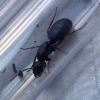
Sent from my iPhone using Tapatalk


it is leaning more towards the festinatus side because of how it is more darker and how it's patter is more similar but don't rely on my info too much
Currently keeping:
1x Formica subsericea, 35-40 workers + maybe eggs *New* 2x Camponotus nova, one has only larva
1x Crematogaster cerasi, All workers is ded ![]() *extreme internal screaming* 1x Myrmica ruba sp around 10 workers + pupa
*extreme internal screaming* 1x Myrmica ruba sp around 10 workers + pupa
*New* 1x Temnothorax curvispinosus, 101 or something worker + 3 or 4 royal mom ants + pile of white ant worms
*As you watch your ants march, remember that every thing begins with a small step and continued by diligence and shared dreams* -A.T (which is Me)
Sadly due to unforeseen consequences, I will soon be giving away my colonies (I will miss them though ![]() )
)
My advice is to wait and learn more before offering ids you are not confident about.it is leaning more towards the festinatus side because of how it is more darker and how it's patter is more similar but don't rely on my info too much
Keeping:
5x - S. molesta (founding) 2x - C. pennsylvanicus (colonies)
4x - C. chromaiodes (colonies)
4x - T. immigrans (founding queens and colonies)
1x - F. subsericea (founding)
Check out my C. nearcticus journal here: https://www.formicul...cticus-journal/
Check out my C. chromaiodes journal here: https://www.formicul...aiodes-journal/
Looks like C pudurosus, a member of the festinatus complex. looks like fragilis but dark, generally found alongside them and flies at the same exact time.
i assume this came from mexico, az or new mexico- the species is largely mexican and central-american and barely pokes into arizona and extreme southwest new mexico.
festinatus, fragilis and absquatulator look identical almost but festinatus has an obvious carina on the clypeus which is how you easily distinguish it from its siblings.
Edited by mbullock42086, August 4 2024 - 9:44 PM.
Camponotus vafer and C. pudorusus have similar coloration to the gyne depending on locale. It's one of the few times color can actually be that helpful. If it's from Arizona, then it is not C. pudorosus - if it's from Mexico, the chance of it being C. pudorosus is more likley due to C. pudorosus appearing to be a complex of 2-3 species. Camponotus fragilis is about as far from this queen as you can get. This is also assuming these are from North America to begin with, haha.
Camponotus vafer and C. pudorusus have similar coloration to the gyne depending on locale. It's one of the few times color can actually be that helpful. If it's from Arizona, then it is not C. pudorosus - if it's from Mexico, the chance of it being C. pudorosus is more likley due to C. pudorosus appearing to be a complex of 2-3 species. Camponotus fragilis is about as far from this queen as you can get. This is also assuming these are from North America to begin with, haha.
didn't know that. explains the unusual 'dark' form with the black head.
0 members, 1 guests, 0 anonymous users